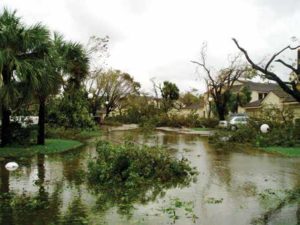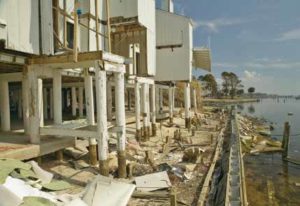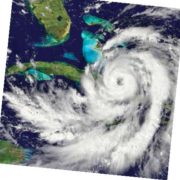It’s that time of year
 by Reg Buxton in collaboration with
by Reg Buxton in collaboration with
Jim von Rinteln, M.A., FPEM, CEM, CFM
The old hurricane saying advises “Hide from the wind and run from the water.” While Hurricane Wilma was a damaging storm which scarred our city for many months after its impact on October 24, 2005 – she graciously brought no storm surge flooding with her.
The National Weather Service describes Storm Surge as: An abnormal rise of water generated by a tropical cyclone, over and above the predicted astronomical tides. This rise in water level can cause extreme flooding in coastal areas particularly when a storm surge coincides with normal high tide. A storm surge is mainly produced by water being pushed toward the shore by the force of the winds moving cyclonically around the center of the storm.
This flooding, which occurs during the storm and recedes after the storm passes, is not only damaging to all that stands in its way – but it is also the biggest threat to life itself. The potential for a storm surge is the primary reason for evacuating the city and other coastal areas in the face of a hurricane threat.
On September 9, 1960 Hurricane Donna passed over coastal Collier County as a category 4 hurricane bringing 135 mph winds and a significant storm surge. The storm surge depth was measured at 11.3 feet MSL (sic) feet at the Naples Pier, which was severely damaged by the storm. Since then Naples has been spared a flooding hurricane, with Tropical Storm Gabrielle in 2001 being the most recent storm to have any significant surge which measured about 3–4 feet around the City. Flooding hurricanes
are not that uncommon to Naples, significant surge events associated with hurricanes are said to have occurred in 1876, 1910, 1926, 1944 and 1947 (although records are incomplete as there were few people living in the area during those hurricanes.)
 Modern building codes have done much to improve the resiliency of our homes and businesses from the high winds associated with a hurricane, less so with flooding – primarily requiring higher elevations (base flood elevation) and hydrostatic foundation
Modern building codes have done much to improve the resiliency of our homes and businesses from the high winds associated with a hurricane, less so with flooding – primarily requiring higher elevations (base flood elevation) and hydrostatic foundation
venting (flood vents). Flood insurance, which is generally required if you have a mortgage on your property, is the only other line of defense available to protect our property from storm surge flooding. To insure that you are properly protected, a review
of your insurance with your carrier, along with the building’s elevation certificate to make sure that they are accurate and cover
what you think they cover is in order. Commercial properties can be tricky, especially if they are beachfront condominiums, hiring a professional is sometimes necessary to make sure you have the proper information, your property is mapped correctly and your coverage is correct.
Preparedness and some common sense will protect you and your family. The Collier County All Hazards Guide, which together some of the other hurricane information available from the Naples City Government can provide you with what you need to know about preparedness and evacuation. These guides are available at the Naples Library, City Hall and several other locations around the City. Take a little time now to prepare for hurricane season – then enjoy a quiet and beautiful summer here on our island paradise.




Leave a Reply
Want to join the discussion?Feel free to contribute!